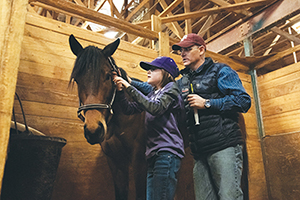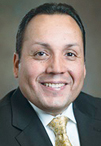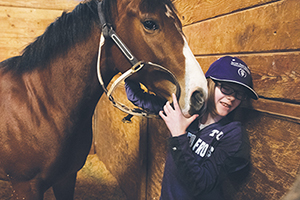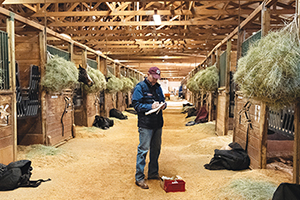By KEN LEISER

Clayton McCook helps his daughter Lily, 10, calm a horse in a stable at Remington Park horse racing track in Oklahoma City. Lily McCook requires daily insulin for her Type 1 diabetes. Whitney Bryen/© CHA
Clayton McCook still remembers the first visit to the pharmacy after his daughter Lily was diagnosed with Type 1 diabetes seven years ago.
The pharmacy technician in Oklahoma City handed him a supply of insulin, syringes and test strips at a cost of about $750. McCook, an equine veterinarian, had health insurance through his employer but his policy carried a $2,500 deductible. Because the family had not yet met that deductible, McCook paid the full retail price — without benefiting from the discounts offered to middlemen or health plans — for the insulin and initial supplies. The insurer-negotiated discount would not kick in until after the family had satisfied the deductible. Since that day, the cost of Lily's insulin has doubled.
Lily McCook, now 10, is among the 1.5 million Americans with Type 1 diabetes whose bodies do not produce insulin, a hormone essential to maintaining a proper blood glucose level. Having access to prescription insulin is a matter of life or death.
Patients with Type 1 diabetes require insulin injections to prevent diabetic ketoacidosis, a potentially deadly condition. (Some patients with Type 2 diabetes also require insulin injections.) Over the long term, diabetes may cause major, sometimes fatal health complications including heart disease and circulatory problems and kidney failure. Regulating blood glucose levels with insulin can mitigate that long-term risk.
In recent years, the price of insulin — including NovoLog, the maker of the insulin Lily now uses — has spiked to levels that create hardships for many patients and their families. In a 2018 survey by the American Diabetes Association, about one-fourth of respondents admitted to rationing their insulin or skipping doses because of high out-of-pocket costs.

Ruiz

Stephens
Congressional investigations
In February leaders of the U.S. Senate Committee on Finance announced they would investigate the industry's insulin pricing practices. The price increases have been most acute in recent times, with the average price of insulin nearly tripling between 2002 and 2013, according to the American Diabetes Association. A vial of Eli Lilly's Humalog went from $21 in 1996 to its current list price of $275 — a 13-fold increase, U.S. Sen. Ron Wyden, D-Ore., said at a January finance committee hearing.
Two House committees have announced their own probes.
In the meantime, endocrinologists including Dr. Martin Ruiz with the CHRISTUS St. Vincent Medical Group in Santa Fe, N.M., and Dr. Elizabeth Stephens, medical director for endocrinology for Providence Medical Group in Portland, Ore., said it is becoming more common for patients to reduce their insulin dose to stretch their supplies, or sometimes go without the drug because they can't afford it.
Uninsured patients and patients with high deductibles and high co-pays can take the brunt of the insulin price increases. Patients with Medicare prescription drug coverage get some pricing protection from the Affordable Care Act, which gradually reduced the drug benefit coverage gap known as the "doughnut hole," and from the Bipartisan Budget Act, which eliminated the doughnut hole for brand name medications beginning this year.

Lily McCook often assists her father, Clayton, an associate veterinarian with Equine Sports Medicine and Surgery in Oklahoma City. Lily was diagnosed with Type 1 diabetes at age 3. Clayton McCook has been outspoken critic of insulin prices and is an advocate for the nonprofit Patients for Affordable Drugs. Whitney Bryen/© CHA
Work-arounds
Some patients purchase insulin by mail from Canada at about one-third of the U.S. price, said Dr. Lillian Harstine, an endocrinologist with Joslin Diabetes Center Affiliate at HSHS Medical Group in Effingham, Ill.
Other patients who can't afford to purchase prescription insulin are buying ReliOn, an older generation of human insulin made by Novo Nordisk and now sold exclusively at Walmart. The injectable product is available without a prescription and retails for $24.88 a vial. (Some doctors advise that its effectiveness in controlling blood sugar is limited, as these insulins are shorter acting than today's brands).
Patients who meet income eligibility criteria may qualify for assistance programs offered through brand name manufacturers, health clinics or other entities.

Haenel
Still, Dr. Louis Haenel, an endocrinologist with Roper St. Francis Physician Partners Endocrinology in Charleston, S.C., said patients are frustrated at having to jump through hoops. Insulin is not a luxury, it's an absolute need, he said. "And so for the cost of these (newer insulins) to be so high and to have risen so much is a bothersome issue."
Insulin pricing
Insulin was first used as a treatment for diabetes nearly 100 years ago. The first generations of drugs were distilled from the pancreases of slaughtered animals. In the 1970s, labs made human insulin from bacteria. A decade later, a recombinant DNA product improved the drugs' efficacy. In the 1990s, analogs were added to formulas to make human insulin longer lasting. Those analog drugs are the most expensive of the lot.
There are three primary manufacturers of insulin — Eli Lilly, Novo Nordisk and Sanofi.
There are generic forms of insulin that are produced by those same manufacturers, but the price is usually just 10 percent less than the name brand, Stephens said. In March, Eli Lilly announced it would sell a generic version of its best-selling fast acting insulin, Humalog, at a pre-discount price of just over $137 a vial (or 50 percent lower than brand name Humalog). The generic and brand name Humalog drugs are not just biosimilar, they are the same, Dr. Vincent Rajkumar a hematologist at the Mayo Clinic in Rochester, Minn., said in a March 10 story by NPR that was part of a reporting collaboration with Kaiser Health News.
In a public policy statement issued last year, the American Diabetes Association said the reasons for the rapid price increases for insulin in the past five years are "not entirely clear," but the answers lie in part in "the complexity of the drug supply chain."
The association is calling for greater transparency in the supply chain that begins with drugmakers and involves pharmacy benefit managers, health plans and drug retailers. It also recommends increasing competition and generics, and redesign of cost-sharing between health plans and patients.

Clayton McCook records notes while providing routine care for horses at Remington Park race track in Oklahoma City. McCook and his wife, Cindy, have discussed moving to Canada, so their daughter would be eligible for that country's publicly funded health care system. Whitney Bryen/© CHA
The McCooks' story
Lily McCook was 3 years old when the family's doctor at a Mercy health system facility in Oklahoma City diagnosed her with Type 1 diabetes. Her mother, Cindy, had sought medical care when she noticed her daughter had classic symptoms of diabetes. Lily had lost quite a bit of weight, had to urinate frequently, and had displayed uncharacteristic irritability, at times. Her breath smelled fruity.
The McCooks learned to monitor Lily's carbohydrate intake, to check her blood sugar, calculate her insulin dose, and keep her still for three to four insulin injections each day.
Clayton McCook embarked on an education of his own. He learned that families with high-deductible plans can pay more than the list price for a vial of insulin, or about $340 for the pre-discount price of the NovoLog Lily uses, he said. She requires about one and a half vials monthly, which is administered through an insulin pump.
McCook learned about the supply chain between pharmaceutical manufacturers and the patient — something he described as "a convoluted mess."
McCook, who cares for racehorses, knows his family would be hard-pressed to afford the insulin and medical products Lily needs should anything happen to him. "My patients are 1,200 pounds," he said. "My circumstances could change with one kick."
The McCooks have talked about moving to Canada where, as a dependent, Lily would be eligible for Canadian health care once her parents achieved permanent resident status.
"It's something that we may very well do before she's 18 to at least give her that opportunity to live in a country where it's not such a burden on her," he said.